Abstract
In four infants with renal tubular acidosis (RTA), including three with apparently classic RTA and one with Fanconi syndrome (FS), the physiologic character of the renal acidification defect was investigated. In two of the infants with apparently classic RTA, the acidification defect was physiologically separable from that described in both adult patients and children with classic RTA (type 1 RTA) in the following ways. (a) The fractional excretion of filtered bicarbonate (CHCO3̄/Cln) was not trivial but substantial (6-9%), as well as relatively fixed, over a broad range of plasma bicarbonate concentrations (15-26 mmoles/liter). (b) This value of CHCO3̄/Cln, combined with a normal or near normal glomerular filtration rate, translated to renal bicarbonate wasting (RBW). (c) RBW at normal plasma bicarbonate concentrations was the major cause of acidosis, and its magnitude was the major determinant of corrective alkali therapy (5-9 mEq/kg per day), just as in the patient with FS, who was found to have type 2 (“proximal”) RTA. (d) Persistence of RBW at substantially reduced plasma bicarbonate concentrations, which did not occur in FS, accounted for the spontaneous occurrence of severe acidosis and its rapid recurrence after reduction in alkali therapy. (e) During severe acidosis the urinary pH was >7, a finding reported frequently in infants with apparently classic RTA and “alkali-resistant” acidosis but rarely in adult patients with classic RTA. Continued supplements of potassium were required to maintain normokalemia during sustained correction of acidosis with alkali therapy. Yet, in at least two of the three infants with apparently classic RTA, but in distinction from the patient with FS and other patients with type 2 RTA, fractional excretion of filtered potassium decreased when plasma bicarbonate was experimentally increased to normal values. In one of the two infants with apparently classic RTA and RBW, CHCO3̄/Cln and the therapeutic alkali requirement decreased concomitantly and progressively over 2 yr, but RBW continued. Renal tubular acidosis has persisted in all four patients for at least 3 yr, and in three for 4 years.
Full text
PDF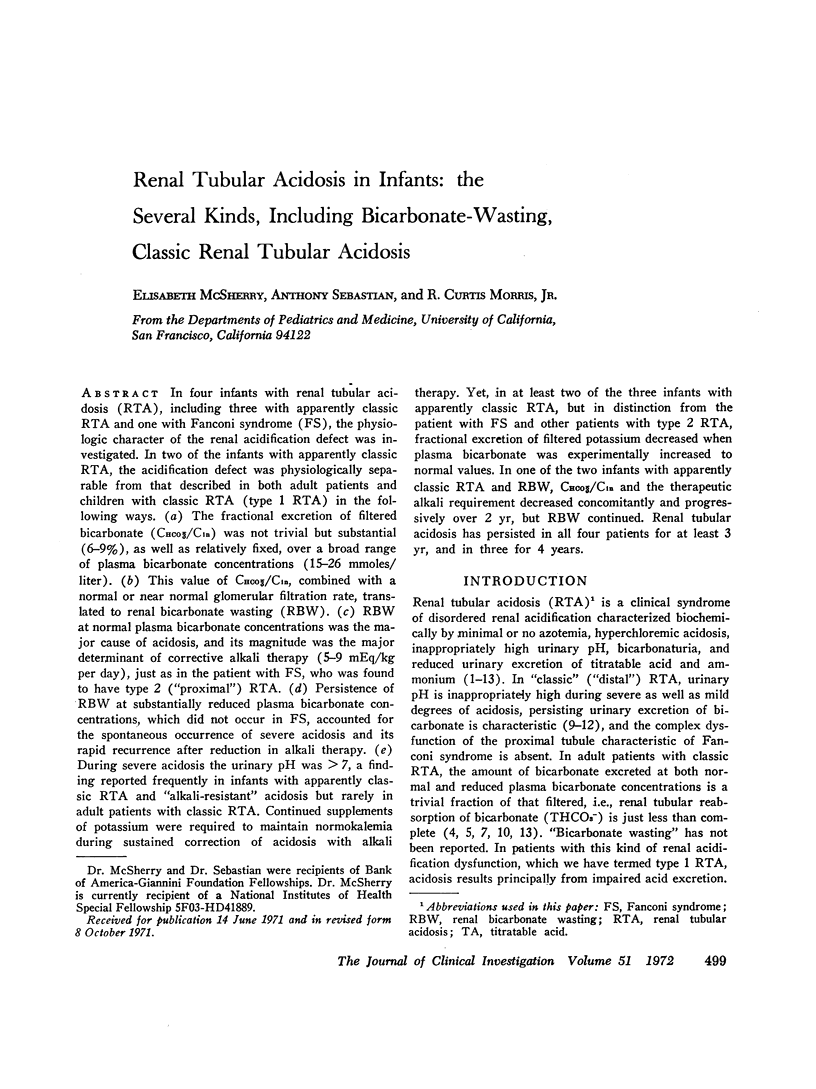
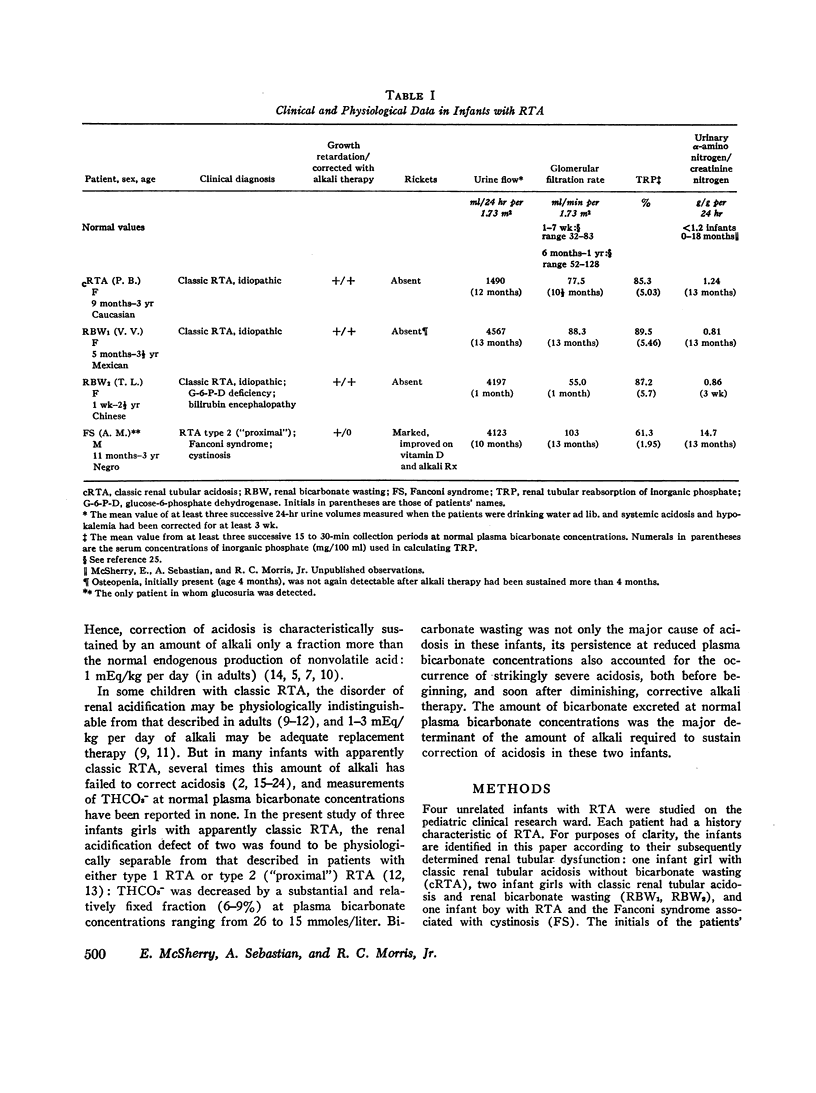
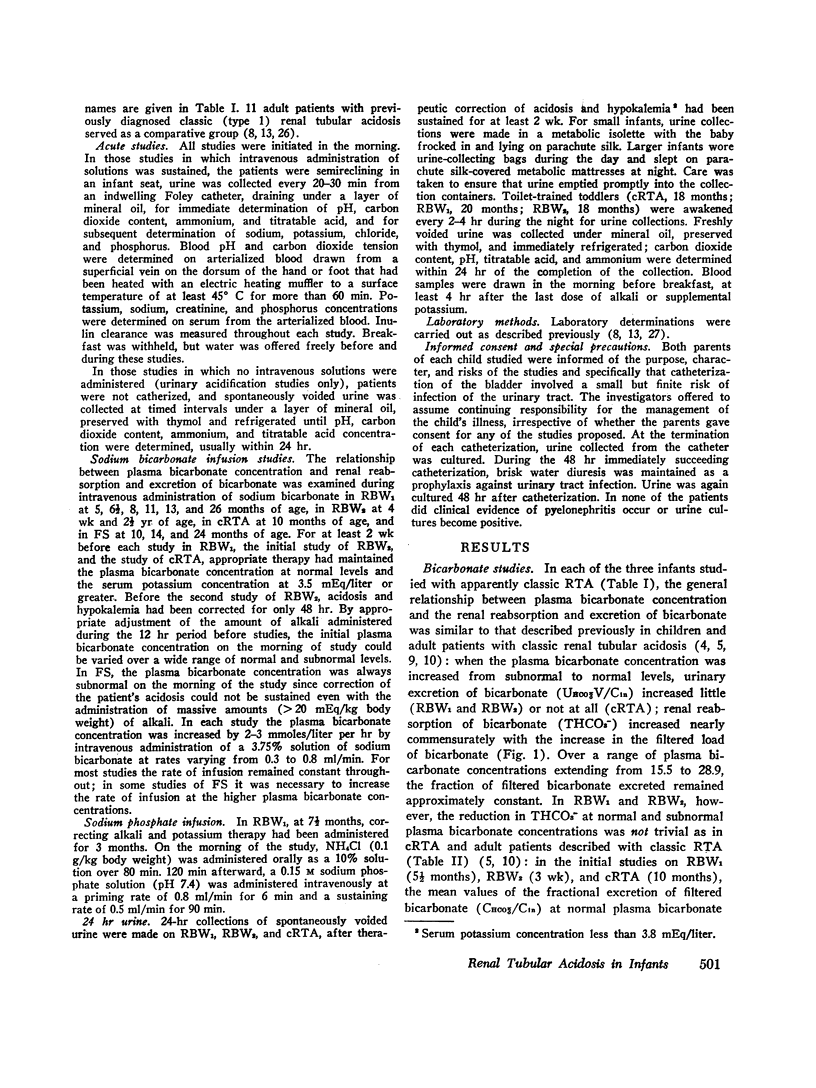
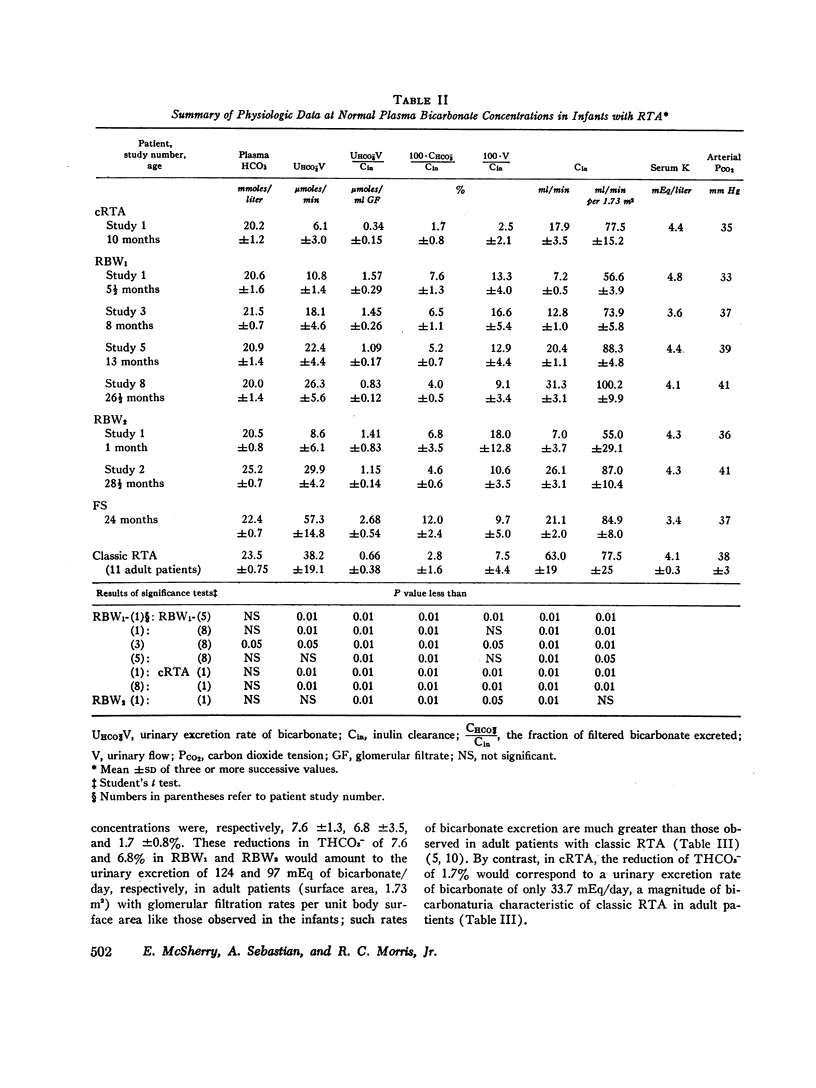
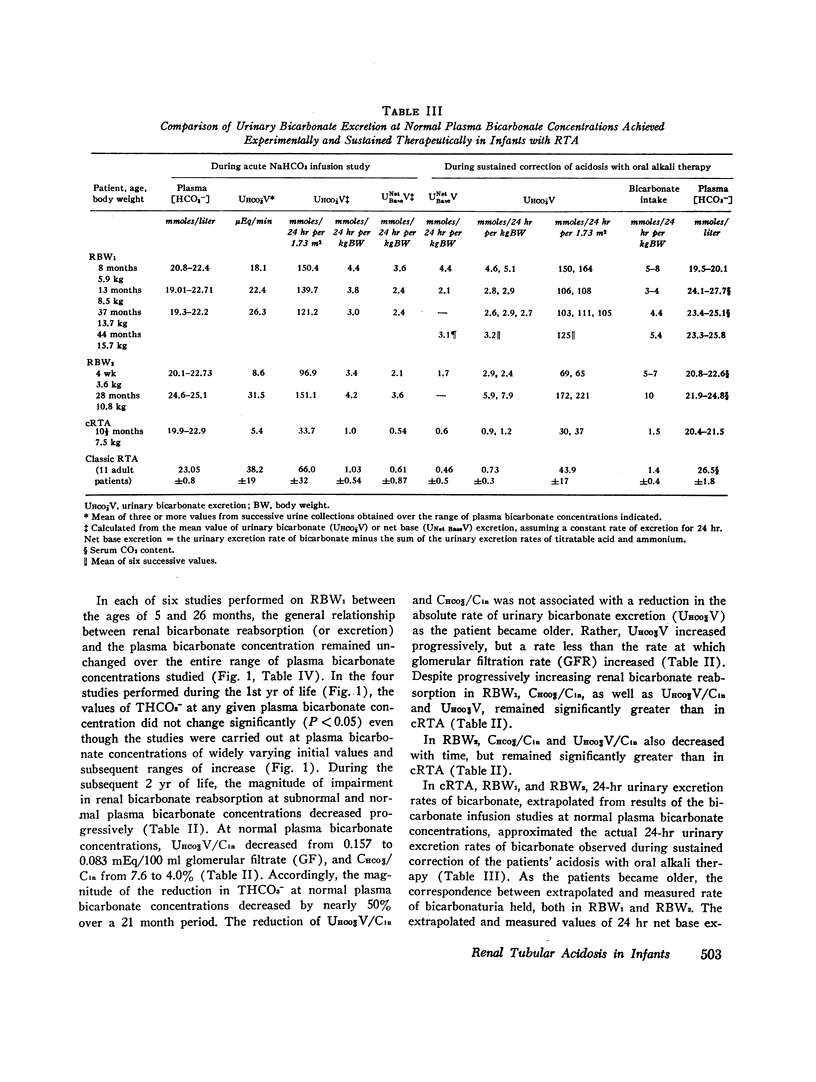
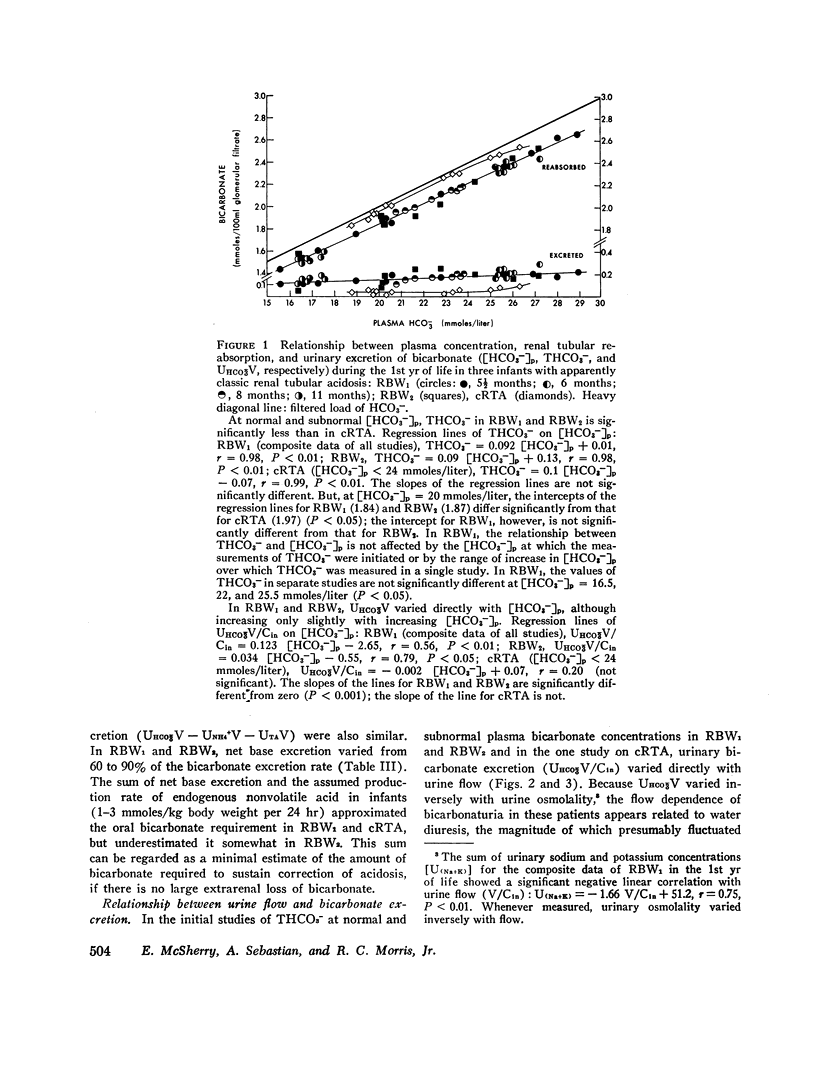
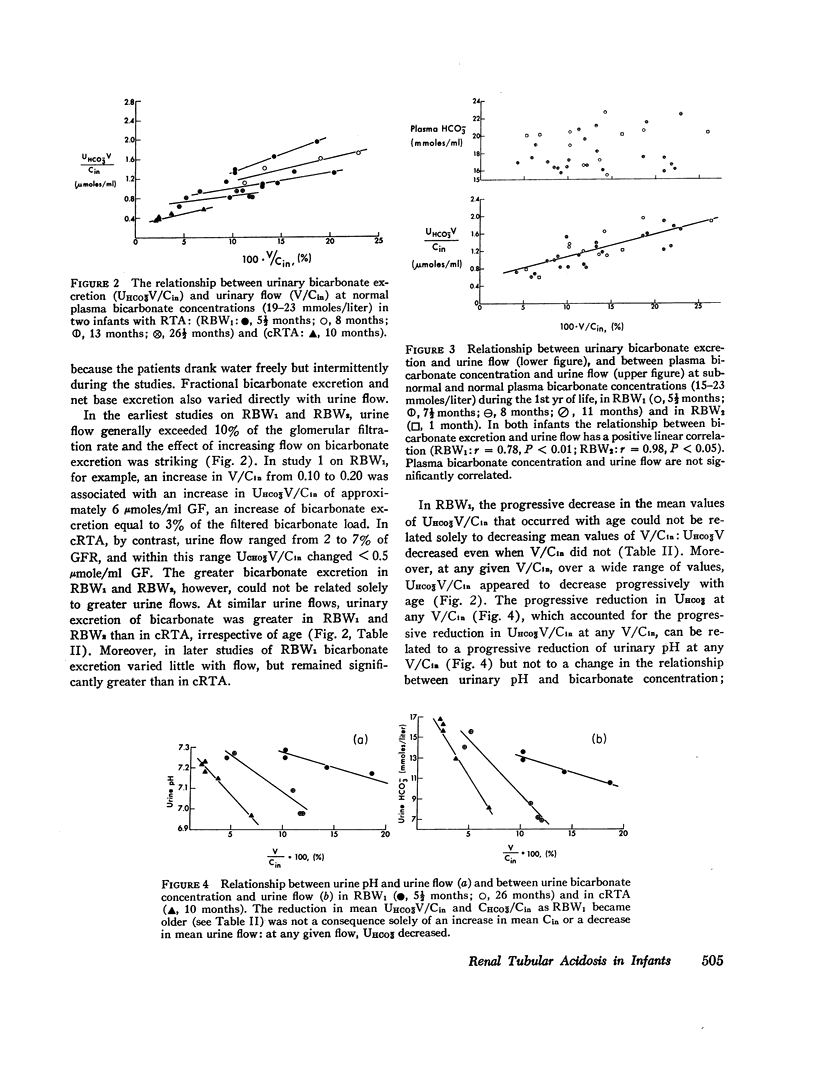
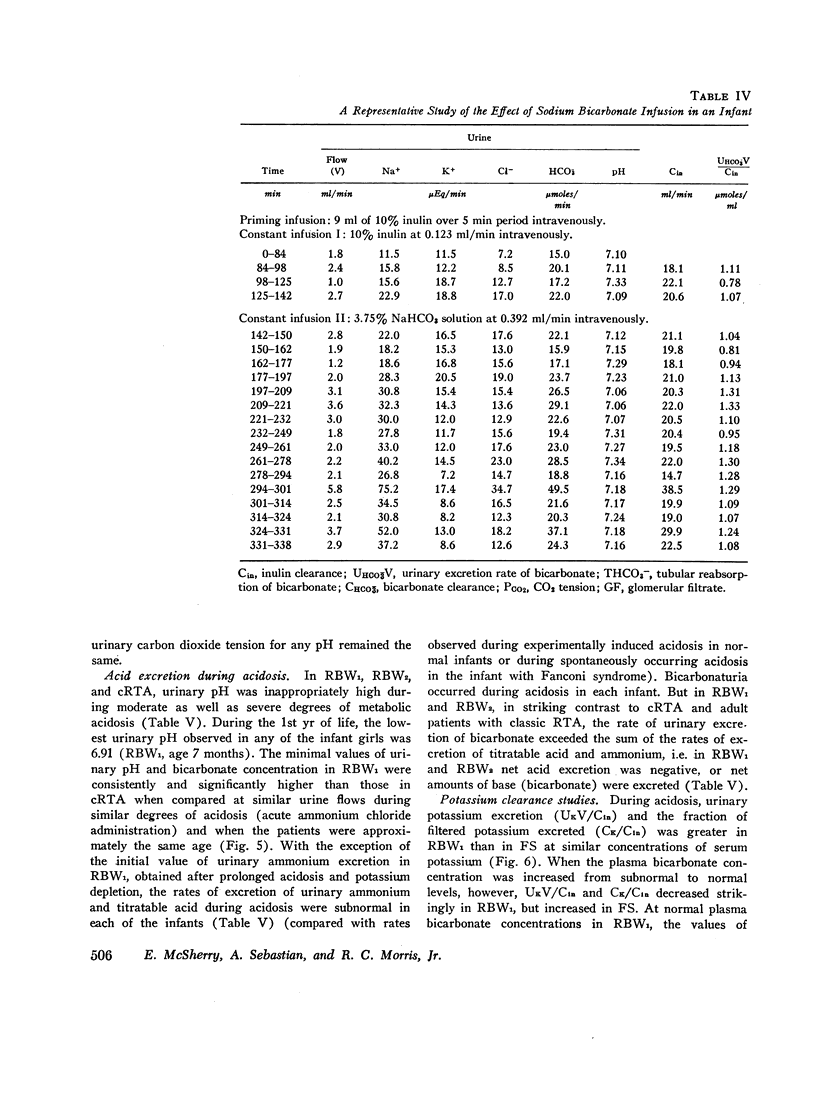
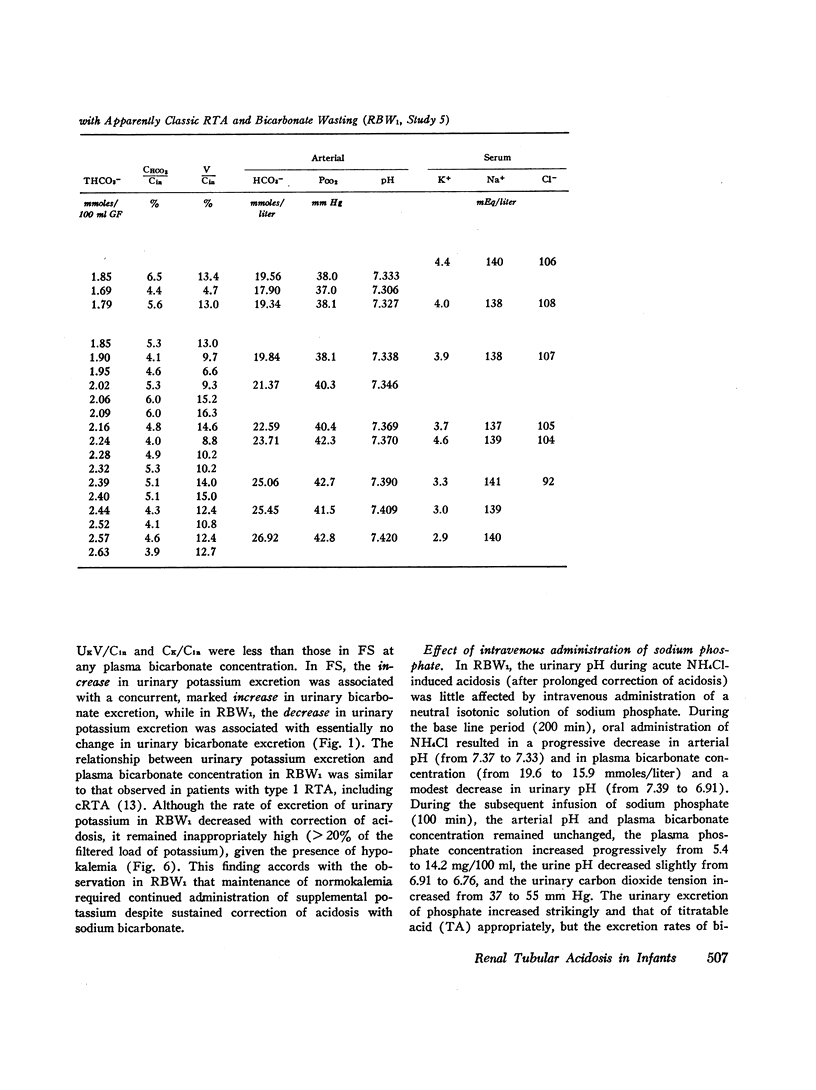

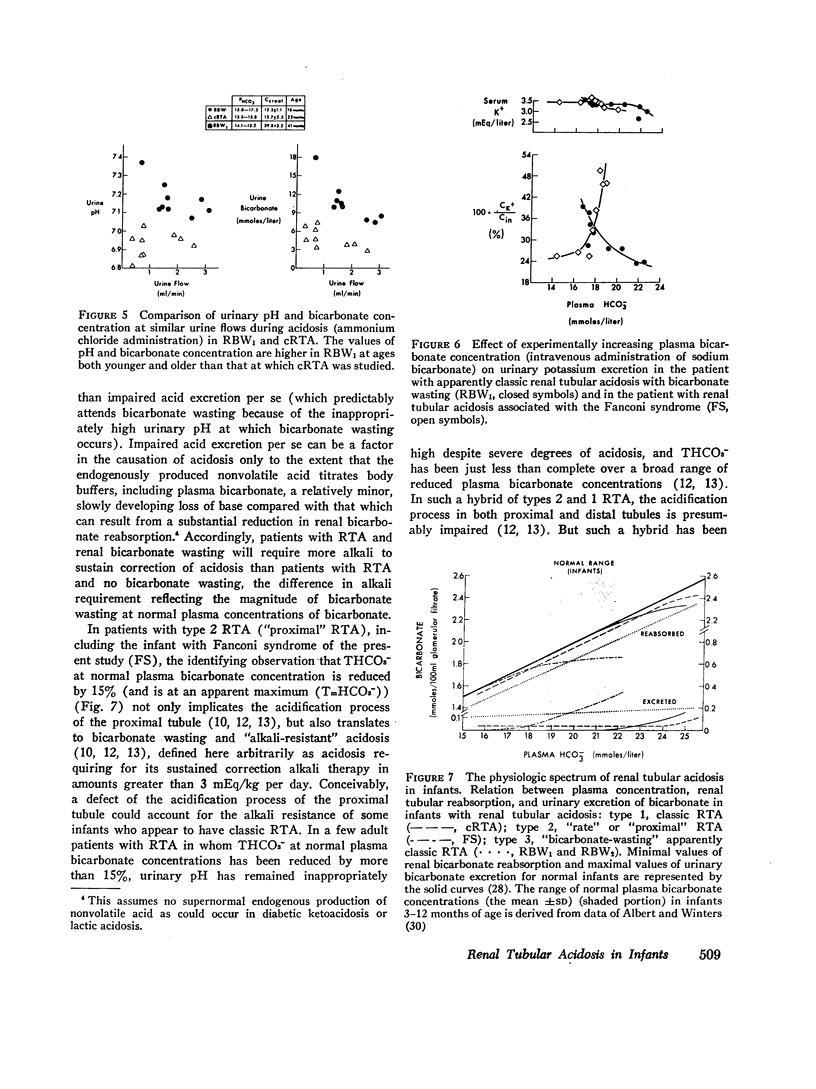
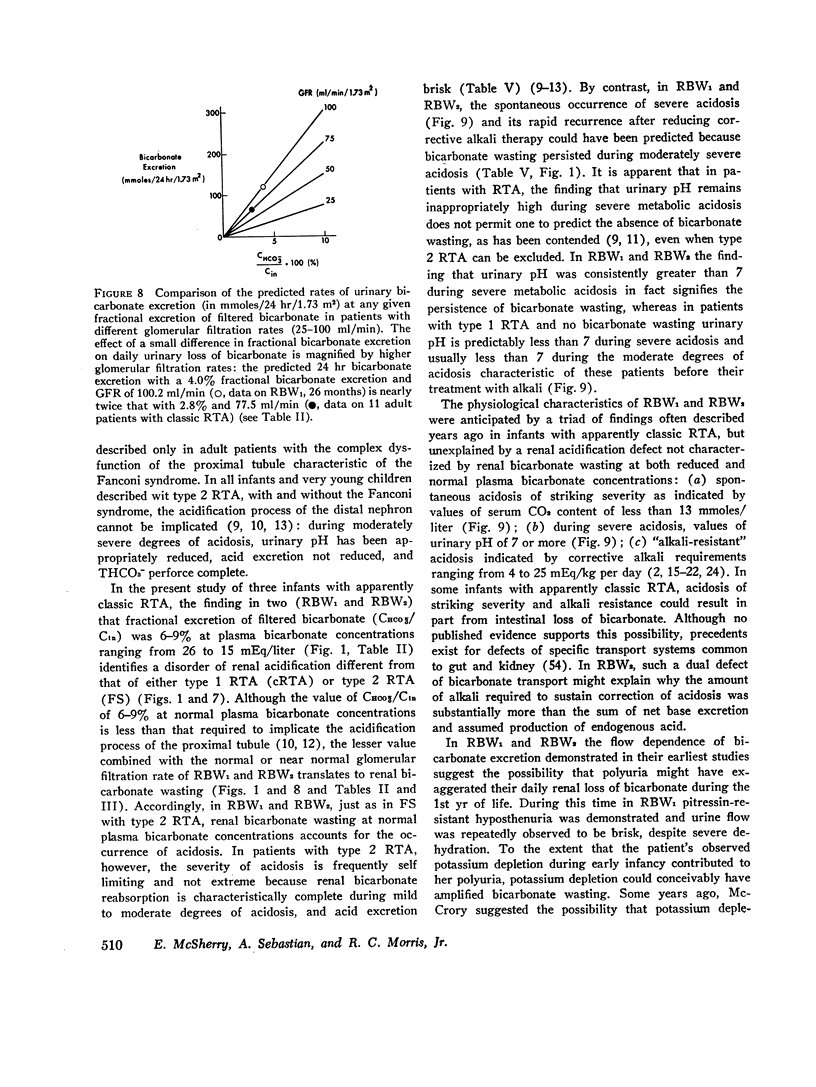
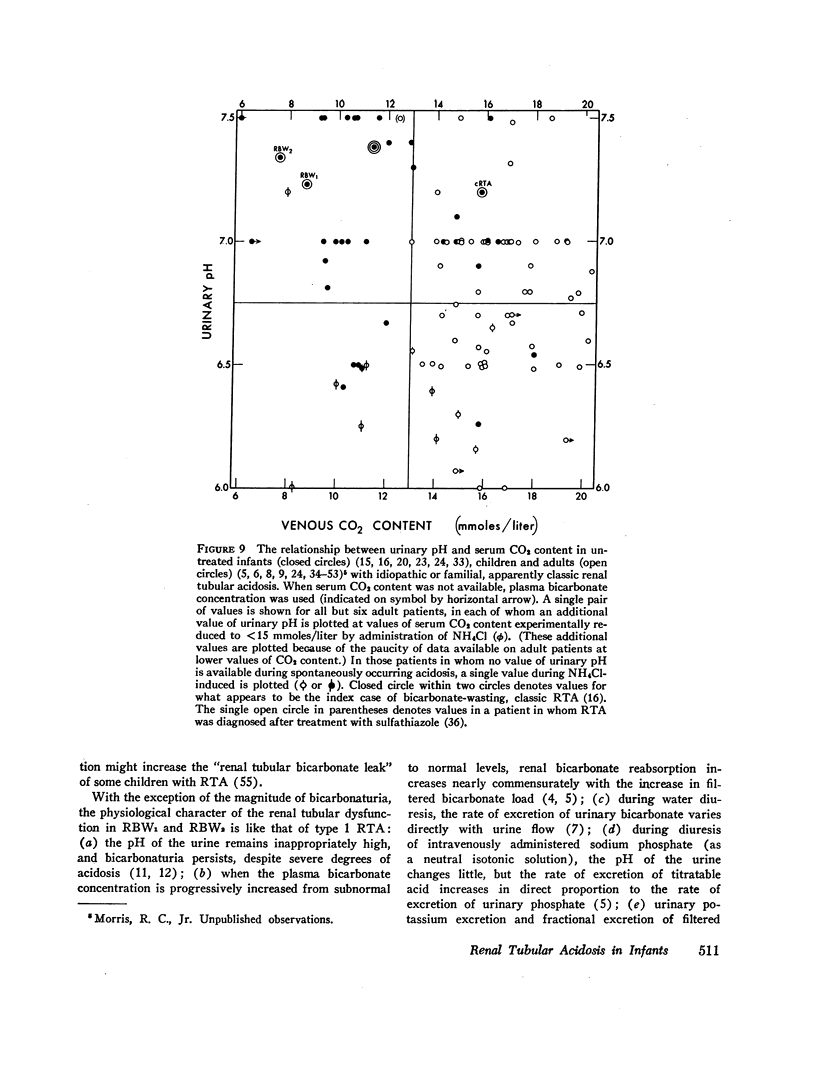
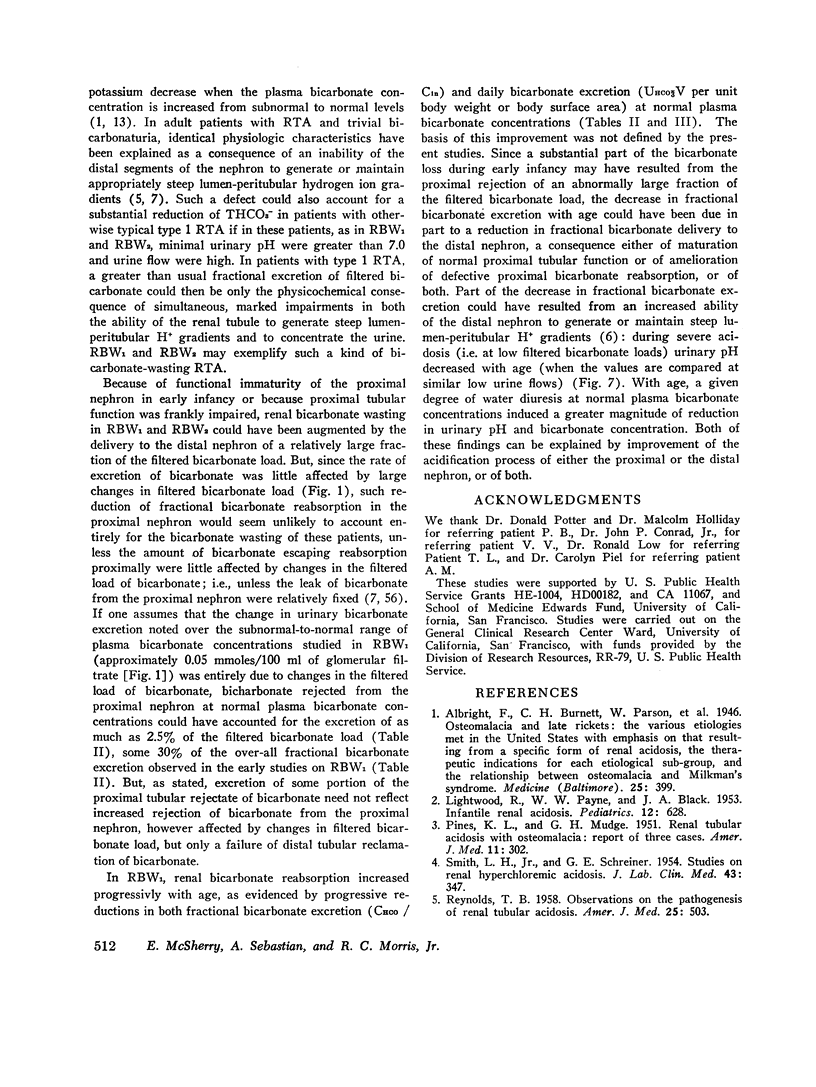
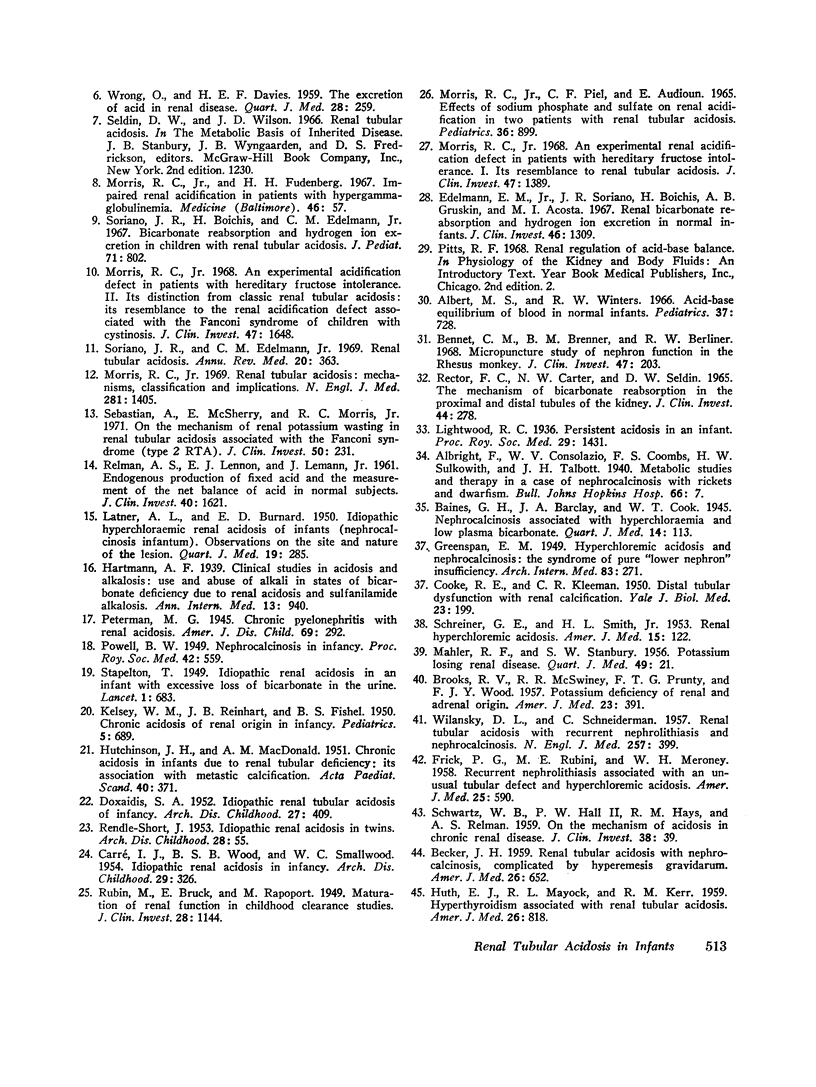
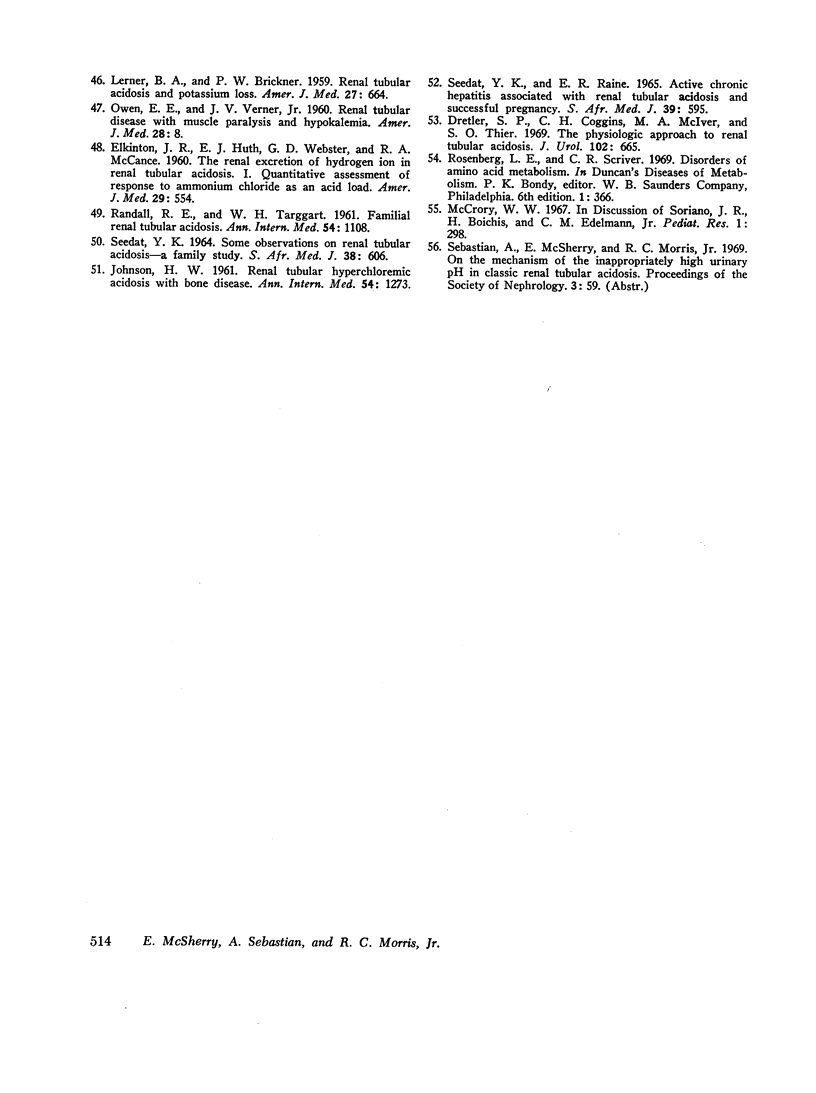
Images in this article
Selected References
These references are in PubMed. This may not be the complete list of references from this article.
- Albert M. S., Winters R. W. Acid-base equilibrium of blood in normal infants. Pediatrics. 1966 May;37(5):728–732. [PubMed] [Google Scholar]
- BECKER J. H. Renal tubular acidosis with nephrocalcinosis, complicated by hyperemesis gravidarum. Am J Med. 1959 Apr;26(4):652–654. doi: 10.1016/0002-9343(59)90286-4. [DOI] [PubMed] [Google Scholar]
- BROOKS R. V., McSWINEY R. R., PRUNTY F. T., WOOD F. J. Potassium deficiency of renal and adrenal origin. Am J Med. 1957 Sep;23(3):391–407. doi: 10.1016/0002-9343(57)90319-4. [DOI] [PubMed] [Google Scholar]
- Bennett C. M., Brenner B. M., Berliner R. W. Micropuncture study of nephron function in the rhesus monkey. J Clin Invest. 1968 Jan;47(1):203–216. doi: 10.1172/JCI105710. [DOI] [PMC free article] [PubMed] [Google Scholar]
- CARRE I. J., WOOD B. S., SMALLWOOD W. C. Idiopathic renal acidosis in infancy. Arch Dis Child. 1954 Aug;29(146):326–333. doi: 10.1136/adc.29.146.326. [DOI] [PMC free article] [PubMed] [Google Scholar]
- COOKE R. E., KLEEMAN C. R. Distal tubular dysfunction with renal calcification. Yale J Biol Med. 1950 Dec;23(3):199–206. [PMC free article] [PubMed] [Google Scholar]
- DOXIADIS S. A. Idiopathic renal acidosis in infancy. Arch Dis Child. 1952 Oct;27(135):409–427. doi: 10.1136/adc.27.135.409. [DOI] [PMC free article] [PubMed] [Google Scholar]
- Dretler S. P., Coggins C. H., McIver M. A., Thier S. O. The physiologic approach to renal tubular acidosis. J Urol. 1969 Dec;102(6):665–669. doi: 10.1016/s0022-5347(17)62227-4. [DOI] [PubMed] [Google Scholar]
- ELKINTON J. R., HUTH E. J., WEBSTER G. D., Jr, McCANCE R. A. The renal excretion of hydrogen ion in renal tubular acidosis. I. quantitative assessment of the response to ammonium chloride as an acid load. Am J Med. 1960 Oct;29:554–575. doi: 10.1016/0002-9343(60)90090-5. [DOI] [PubMed] [Google Scholar]
- EVANS P. R. Nephrocalcinosis in infancy. Proc R Soc Med. 1949 Jul;42(7):559–559. doi: 10.1177/003591574904200724. [DOI] [PMC free article] [PubMed] [Google Scholar]
- Edelmann C. M., Soriano J. R., Boichis H., Gruskin A. B., Acosta M. I. Renal bicarbonate reabsorption and hydrogen ion excretion in normal infants. J Clin Invest. 1967 Aug;46(8):1309–1317. doi: 10.1172/JCI105623. [DOI] [PMC free article] [PubMed] [Google Scholar]
- FRICK P. G., RUBINI M. E., MERONEY W. H. Recurrent nephrolithiasis associated with an unusual tubular defect and hyperchloremic acidosis. Am J Med. 1958 Oct;25(4):590–599. doi: 10.1016/0002-9343(58)90048-2. [DOI] [PubMed] [Google Scholar]
- HUTCHISON J. H., MacDONALD A. M. Chronic acidosis in infants due to renal tubular deficiency: its association with metastatic calcification. Acta Paediatr. 1951 Sep;40(5):371–400. doi: 10.1111/j.1651-2227.1951.tb16504.x. [DOI] [PubMed] [Google Scholar]
- HUTH E. J., MAYOCK R. L., KERR R. M. Hyperthyroidism associated with renal tubular acidosis; discussion of possible relationship. Am J Med. 1959 May;26(5):818–826. doi: 10.1016/0002-9343(59)90240-2. [DOI] [PubMed] [Google Scholar]
- JOHNSON H. W. Renal tubular hyperchloremic acidosis with bone disease: a case report. Ann Intern Med. 1961 Jun;54:1273–1280. doi: 10.7326/0003-4819-54-6-1273. [DOI] [PubMed] [Google Scholar]
- KELSEY W. M., REINHART J. B., FISHEL J. Chronic acidosis of renal origin in infancy. Pediatrics. 1950 Apr;5(4):689–694. [PubMed] [Google Scholar]
- LERNER B. A., BRICKENER P. W. Renal tubular acidosis and potassium loss. Am J Med. 1959 Oct;27:664–672. doi: 10.1016/0002-9343(59)90050-6. [DOI] [PubMed] [Google Scholar]
- LIGHTWOOD R., PAYNE W. W., BLACK J. A. Infantile renal acidosis. Pediatrics. 1953 Dec;12(6):628–644. [PubMed] [Google Scholar]
- Lightwood R., Maclagan N. F., Williams J. G. Persistent Acidosis in an Infant: Cause not yet ascertained. Proc R Soc Med. 1936 Sep;29(11):1431–1433. doi: 10.1177/003591573602901110. [DOI] [PMC free article] [PubMed] [Google Scholar]
- MAHLER R. F., STANBURY S. W. Potassium-losing renal disease; renal and metabolic observations on a patient sustaining renal wastage of potassium. Q J Med. 1956 Jan;25(97):21–52. [PubMed] [Google Scholar]
- Morris R. C., Jr An experimental renal acidification defect in patients with hereditary fructose intolerance. I. Its resemblance to renal tubular acidosis. J Clin Invest. 1968 Jun;47(6):1389–1398. doi: 10.1172/JCI105830. [DOI] [PMC free article] [PubMed] [Google Scholar]
- Morris R. C., Jr An experimental renal acidification defect in patients with hereditary fructose intolerance. II. Its distinction from classic renal tubular acidosis; its resemblance to the renal acidification defect associated with the Fanconi syndrome of children with cystinosis. J Clin Invest. 1968 Jul;47(7):1648–1663. doi: 10.1172/JCI105856. [DOI] [PMC free article] [PubMed] [Google Scholar]
- Morris R. C., Jr Renal tubular acidosis. Mechanisms, classification and implications. N Engl J Med. 1969 Dec 18;281(25):1405–1413. doi: 10.1056/NEJM196912182812508. [DOI] [PubMed] [Google Scholar]
- Morris R. C., Piel C. F., Audioun E. Renal tubular acidosis. Effects of sodium phosphate and sulfate on renal acidification in two patients with renal tubular acidosis. Pediatrics. 1965 Dec;36(6):899–904. [PubMed] [Google Scholar]
- OWEN E. E., VERNER J. V., Jr Renal tubular disease with muscle paralysis and hypokalemia. Am J Med. 1960 Jan;28:8–21. doi: 10.1016/0002-9343(60)90218-7. [DOI] [PubMed] [Google Scholar]
- PINES K. L., MUDGE G. H. Renal tubular acidosis with osteomalacia; report of 3 cases. Am J Med. 1951 Sep;11(3):302–311. doi: 10.1016/0002-9343(51)90167-2. [DOI] [PubMed] [Google Scholar]
- RANDALL R. E., Jr, TARGGART W. H. Familial renal tubular acidosis. Ann Intern Med. 1961 Jun;54:1108–1116. doi: 10.7326/0003-4819-54-6-1108. [DOI] [PubMed] [Google Scholar]
- RECTOR F. C., Jr, CARTER N. W., SELDIN D. W. THE MECHANISM OF BICARBONATE REABSORPTION IN THE PROXIMAL AND DISTAL TUBULES OF THE KIDNEY. J Clin Invest. 1965 Feb;44:278–290. doi: 10.1172/JCI105142. [DOI] [PMC free article] [PubMed] [Google Scholar]
- RELMAN A. S., LENNON E. J., LEMANN J., Jr Endogenous production of fixed acid and the measurement of the net balance of acid in normal subjects. J Clin Invest. 1961 Sep;40:1621–1630. doi: 10.1172/JCI104384. [DOI] [PMC free article] [PubMed] [Google Scholar]
- RENDLE-SHORT J. Idiopathic renal acidosis in twins; alkalosis resulting from overdosage of a citrate mixture. Arch Dis Child. 1953 Feb;28(137):55–56. doi: 10.1136/adc.28.137.55. [DOI] [PMC free article] [PubMed] [Google Scholar]
- REYNOLDS T. B. Observations on the pathogenesis of renal tubular acidosis. Am J Med. 1958 Oct;25(4):503–515. doi: 10.1016/0002-9343(58)90040-8. [DOI] [PubMed] [Google Scholar]
- Rodriguez-Soriano J., Edelmann C. M., Jr Renal tubular acidosis. Annu Rev Med. 1969;20:363–382. doi: 10.1146/annurev.me.20.020169.002051. [DOI] [PubMed] [Google Scholar]
- Rubin M. I., Bruck E., Rapoport M., Snively M., McKay H., Baumler A. MATURATION OF RENAL FUNCTION IN CHILDHOOD: CLEARANCE STUDIES. J Clin Invest. 1949 Sep;28(5 Pt 2):1144–1162. doi: 10.1172/JCI102149. [DOI] [PMC free article] [PubMed] [Google Scholar]
- SCHREINER G. E., SMITH L. H., Jr, KYLE L. H. Renal hyperchloremic acidosis; familial occurrence of nephrocalcinosis with hyperchloremia and low serum bicarbonate. Am J Med. 1953 Jul;15(1):122–129. doi: 10.1016/0002-9343(53)90060-6. [DOI] [PubMed] [Google Scholar]
- SCHWARTZ W. B., HALL P. W., 3rd, HAYS R. M., RELMAN A. S. On the mechanism of acidosis in chronic renal disease. J Clin Invest. 1959 Jan 1;38(1 Pt 1):39–52. doi: 10.1172/JCI103794. [DOI] [PMC free article] [PubMed] [Google Scholar]
- SEEDAT Y. K. SOME OBSERVATIONS OF RENAL TUBULAR ACIDOSIS--A FAMILY STUDY. S Afr Med J. 1964 Aug 15;38:606–610. [PubMed] [Google Scholar]
- SMITH L. H., Jr, SCHREINER G. E. Studies on renal hyperchloremic acidosis. J Lab Clin Med. 1954 Mar;43(3):347–358. [PubMed] [Google Scholar]
- Sebastian A., McSherry E., Morris R. C., Jr On the mechanism of renal potassium wasting in renal tubular acidosis associated with the Fanconi syndrome (type 2 RTA). J Clin Invest. 1971 Jan;50(1):231–243. doi: 10.1172/JCI106479. [DOI] [PMC free article] [PubMed] [Google Scholar]
- Seedat Y. K., Raine E. R. Active chronic hepatitis associated with renal tubular acidosis and successful pregnancy. S Afr Med J. 1965 Jul 17;39(26):595–597. [PubMed] [Google Scholar]
- Soriano J. R., Boichis H., Edelmann C. M., Jr Bicarbonate reabsorption and hydrogen ion excretion in children with renal tubular acidosis. J Pediatr. 1967 Dec;71(6):802–813. doi: 10.1016/s0022-3476(67)80005-2. [DOI] [PubMed] [Google Scholar]
- WILANSKY D. L., SCHNEIDERMAN C. Renal tubular acidosis with recurrent nephrolithiasis and nephrolithiasis. N Engl J Med. 1957 Aug 29;257(9):399–403. doi: 10.1056/NEJM195708292570903. [DOI] [PubMed] [Google Scholar]
- WRONG O., DAVIES H. E. The excretion of acid in renal disease. Q J Med. 1959 Apr;28(110):259–313. [PubMed] [Google Scholar]



